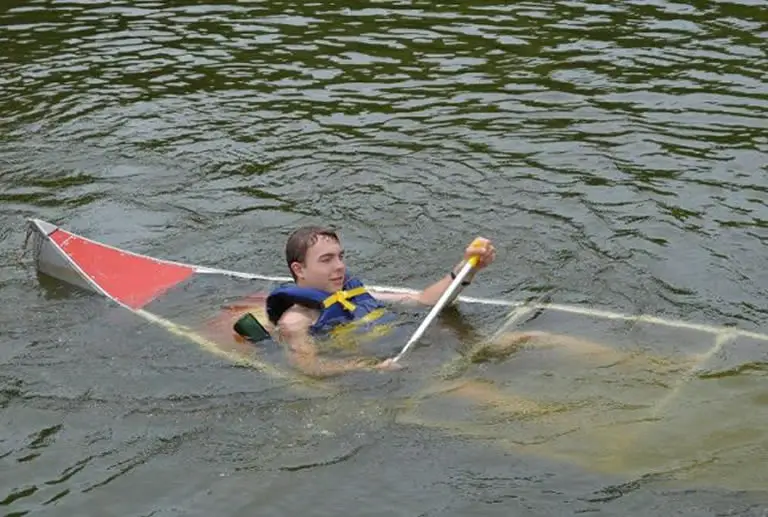Canoeing is a well-loved leisure boating activity. When you see a canoe it tends to be slowly meandering down a river with the canoeists seeming to have no cares in the world. But, are there dangers associated with this water based activity and are there ways to avoid them?
Contents
The Dangers Of Canoeing
Is canoeing dangerous?
Canoeing is one of the least dangerous boating activities when canoeists take the proper safety precautions.
Wearing a PFD and only paddling in the correct type of waters and in the right type of weather is usually enough to stay safe.
Outrigger canoes are actually some of the most stable and safe inland boats on the water.
However, there are hazards associated with canoeing that need to be considered before venturing onto the water.
Canoeing is one of the safest forms of boating when done the right way.
How To Make Canoeing Safer
Probably the most challenging part of canoeing for a beginner is balance.
For a beginner it feels like a canoe is easy to tip.
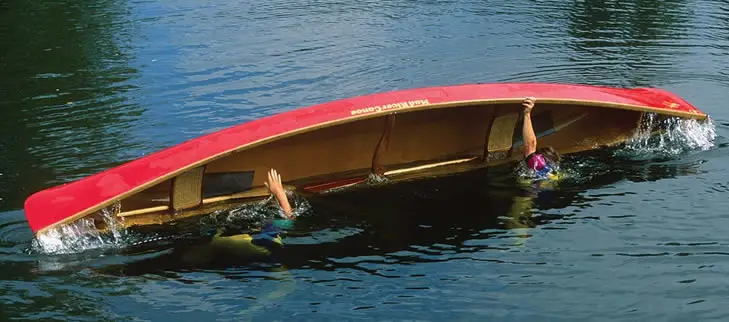
However, there are specific things you can do to help keep your balance in a canoe.
Learn to maintain your balance
Things to do to improve balance on a canoe:
- Lower your center of gravity.
- Lean downstream.
- Ensure you are in the correct canoe type.
- Practice entering and exiting the canoe.
For a more detailed look at the above points read the article why is a canoe easy to tip.
Although balance is a big factor for beginners this is not the biggest cause of problems on a canoe.
By far the biggest thing that will make canoeing dangerous is not taking the proper safety precautions before going on the water.
The same type of dangers that exist for kayakers exist for canoeists because they tend to boat in similar waters.
Take simple safety precautions
Before you enter a canoe you must be wearing a PFD. A PFD (personal flotation device) is a lifesaver and will keep you stay afloat if you fall out of the canoe or the canoe capsizes.
When it comes to canoeing, wearing a PFD should be non-negotiable!
Good quality PFDs will be durable and comfortable to wear.
Many include other safety equipment, such as a whistle that is used to alert others that you are in the water and need help.
Be sure to gear up properly
By now you have probably understood what type of dangers canoeing may have in store for you.
Since there may be a chance you are dumped into the water, the most important thing you can do before you get in a canoe is to put on a reliable personal flotation device, such as a life jacket.
You should also wear clothes that can counter the temperature of the water, not the air temperature.
If your canoe tips over and you have to swim in cold water you may have to combat the effects of hypothermia so dress for the water temperature and not the air temperature.
A first aid kit is also a must-have item, as is an ample supply of fresh drinking water.
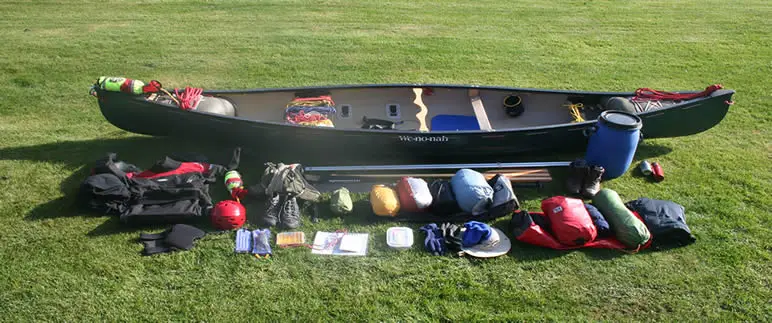
Don’t drink from the river or lake, even if it is freshwater, as there will be hidden microscopic nasties in it.
Use sunscreen and bring some energy snacks.
Also pack a survival kit that includes flashlight and essential electronics, such as your mobile phone and radio.
Place everything in a dry bag, of course.
How To Make The Canoe Even Safer
Although canoes are safe boats, and stable on the water, you can make one even more stable by adding outriggers to it.
Outriggers are stability aids that are attached to one or both sides of a canoe.
They are usually made from PVC tubing, or a similarly buoyant lightweight material, and sit parallel to the sides of canoe acting as stabilizers (think of them as boat versions of the stabilizers attached to kid’s bikes).
Putting outriggers on a canoe stops it from tipping over. You can read more about canoe outriggers here.
How To Stay Safe While Canoeing
Canoeing hazards to avoid
Of course no matter how careful you are you may run into trouble from time to time.
Below are the four most common hazards encountered by canoeists and how to avoid them.
The most common form of canoeing takes place on rivers and so it should come as no surprise that this is where the most dangers lie in wait for the canoeist.
Of course some people do canoe in the ocean. If this is where you plan to take your canoe then you should read the article titled can canoes go in the ocean for more information on that.
River canoeing hazards to be aware of
River canoeing has attracted many paddlers for the sense of fun and adventure it brings.
However, a seemingly “easy” and calm activity can turn into a thrilling water sport when you have to start paddling your canoe in turbulent water.
One moment you may be paddling on smooth water and then suddenly you may find yourself having to paddle frantically to escape rapids the next.
So, to make the most of your adventure in canoeing, and to stay safe, you should understand the different hazards that exist and know how to avoid them.
Rivers can often have unpredictable currents at different parts of the river, there are dangers in the water that you must be aware of.
Additionally there are undercut banks, low-head dams and dangling tree branches that you should be cautious of.
Often, river obstacles can be identified through patterns in the water or simply by scouting the river before setting out with your canoe.
Here are 3 things to keep in mind to avoid river hazards.
- Read the river.
- Avoid weirs and low-head dams.
- Identify potential hazards before you reach them.
Learn to read the river
River currents can be unpredictable and can change quickly as you enter new areas of the river.
If you do not want any surprises as you paddle your canoe, move your boat through a V-shaped downstream flow when you see it.
This pattern means there are no obstructions in this part of the river. You won’t pass through rocks hiding at the bottom.
In contrast, avoid a V-shaped upstream flow. This pattern signifies submerged rocks and boulders that you will want to avoid.
It can also mean there is a web of branches or roots from a fallen tree hidden just below the water surface.
This type of current can trap you and your canoe in the rushing water.
Know you know what to look for you can spot these patterns in the water from afar and navigate your canoe in the correct direction before you get there.
You can easily learn how to read a river and this is a skill you should develop if you intend to canoe regularly.
Avoid a weirs and low-head dams
A weir is a man-made drop in the river, usually 2 – 4 feet in height. It is dangerous because it can hold canoes and paddlers in the underwater current that it produces.
It is mainly created for agricultural purposes and as a power source and is definitely not built to allow boats to pass through.
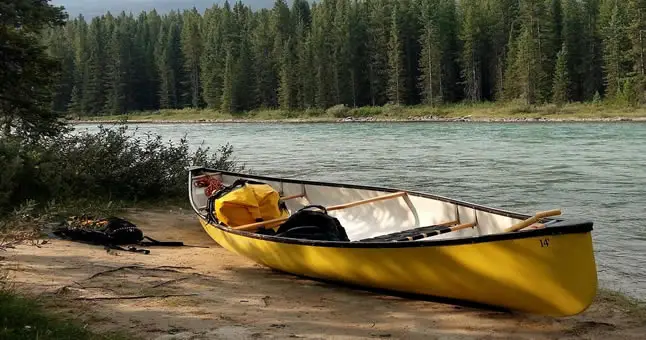
The presence of a weir is often characterized by flat, wide and deep flows that accelerate as they pass over the area.
It is best to identify these locations beforehand and avoid them at all costs.
Identify potential hazards before you reach them
Although you should definitely learn to read the river so you can identify signs of potential hazards before you even hit the water.
Most rivers, especially in national parks, are mapped. A river map will have potential hazard spots clearly marked on it, as well as safe routes for paddlers.
You should get a hold of the river map for the area you intend to canoe on and study your paddling course before your trip.
Moreover, based on the information you gather you can determine which paddling, or rowing (if your canoe is fitted with oars), techniques are best to use at the different parts of the river.
4 Ways To Improve Your Paddling Skills
Whether you are a beginner or an experienced canoeist, your paddling skills can be tested and honed on a river.
Here are some tips to ensure you maximize your river canoeing experience and have fun doing so.
4 Steps for improving your paddling skills:
- Master your paddle strokes.
- Learn synchronized paddling with a companion.
- Maintain balance in your canoe by kneeling while paddling.
- Know what to do if your canoe tips over.
1. Master your paddle strokes
Canoeing, like kayaking, can be a lot more fun when you hit the water with at least one more person onboard, especially if you are going on longer trips or boat camping excursions.
If you do intend to hit the water with a companion then you should agree on having designated roles.
Whoever sits in front scouts the river for hazards and sets the paddling pace as he/she has a clearer line of sight.
The paddler at the rear initiates turns and any corrections needed to bypass spotted hazards.
The reason for this is that the stern does not receive the same amount of water pressure as the bow and the paddler at the rear has much more control over the canoe’s direction.
2. Learn synchronized paddling with your companion
Paddling on opposite sides is highly recommended to keep your canoe tracking in a straight line.
Since a river can be turbulent, this technique will also help to prevent you heaving from side to side.
If you are canoeing solo, it may be prudent to follow a river course closer to the bank.
This way if any maneuvering techniques do not work and you are dumped into the water, you can easily swim to safety.
Just be aware of the hazards near banks such as sweepers and strainers (obstacles just above the waterline and hidden obstacles under the water surface).
If the river is littered with these it is best to move further away from the bank.
3. Maintain balance in your canoe by kneeling while paddling
Kneeling in a canoe is the traditional way to paddle the boat and offers many advantages to sitting especially in rough water.
This is because kneeling achieves two balancing principles:
- It lowers your center of gravity.
- Your body creates a wider contact with the canoe.
Because of these two principles, you and your canoe are more stable, thus reducing the probability of the boat tipping over.
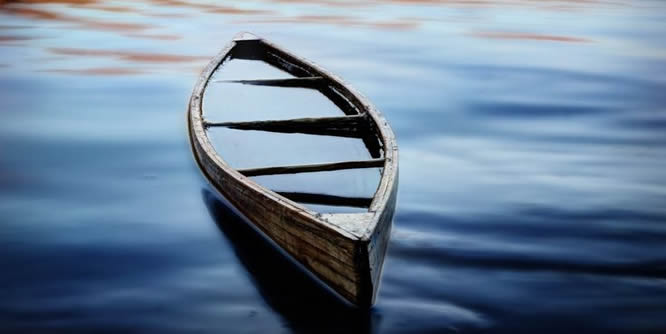
It also gives you better control of the canoe, especially when maneuvering it in a current.
Can’t kneel for a long time? No problem.
Use canoe kneeling pads, or these type of removable knee pads or simply place an appropriately thick foam pad
on the canoe floor.
Any one of these will help to make you more comfortable while paddling though there are other modifications you make that work well also.
4. Know what to do if your canoe tips over
Learn how to do a wet exit because water can fill the canoe fast. Also learn how to re-enter your canoe if the situation permits it.
You can practice these in a very calm shallow river, pond or lake before your river canoe trip.
If you are paddling with another group of people, practice “canoe over canoe” rescues but only if circumstances are ideal.
Otherwise, allow the expert rescuers to do it.
This next rule applies to all types of canoeing but it is usually more important when canoeing in a fast flowing river.
A fast flowing river current can easily separate paddler from canoe and gear quickly.
If you find yourself out of your canoe in fast flowing water, forget the canoe, and head for the safety of the bank as calmly and quickly as you can.
The boat can always be recovered later and repaired if need be.

